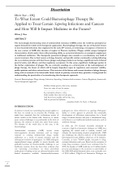To What Extent Could Bacteriophage Therapy Be
Applied to Treat Certain Superbug Infections and Cancers
and How Will It Impact Medicine in the Future?
Oliver J. Xue
ABSTRACT
The increasingly deteriorating crisis of antimicrobial resistance (AMR) across the world has prompted an
urgent demand for viable novel therapeutic approaches. Bacteriophage therapy, the use of bacterial viruses
to treat bacterial infections that originated in the early 20th century, is witnessing a resurgence of interest in
the new context of AMR after decades of neglect in Western medicine. Phages exhibit unique biological
characteristics which endow them with promising ability as a practical alternative or synergistic supplement
to traditional antibiotics. The therapeutic potential of phages also extends to a revolutionary new field of
cancer treatment. Due to their nature as living, dynamic, and specific entities continually evolving following
the co-evolution patterns with their hosts, phages and phage products are facing a significant lack of clinical
proof of safety and efficacy and thus regulatory acceptance. In this sense, significant challenges persist in
the further exploitation of phages. We are currently standing on a critical point of the redevelopment of
phage therapy, the future of which will be largely dependent upon its regulatory and economic viability,
public opinions and other various factors. This overview of the history and current situation of phage therapy,
along with an analysis of its foreseeable future based on primary research data, provides a background for
understanding the practicality of re-introducing this therapeutic approach.
Keywords: Bacteriophage; Phage therapy; Infection; Superbug; Antimicrobial resistance; Cancer; Regulatory framework;
Novel therapeutic approach
Hobbes clearly proves, that every creature
Lives in a state of war by nature.
…………………………………
So, naturalists observe, a flea
Hath smaller fleas that on him prey;
And these have smaller still to bite ‘em,
And so proceed ad infinitum.
– Jonathan Swift, On Poetry: A Rhapsody
INTRODUCTION
Evolution is clearly not something that merely applies to pathogens are often referred to as superbugs. Pathogens’
life here we actually see in everyday life. Perhaps, you ability to evolve appears to preclude the sustainable
might have surmised, that the evolutionary power of development of efficacious interventions for a broad
nature resides in the distant wild. However, as nature range of human diseases and pose a fundamental long-
poses serious challenges to us, particularly in the form of term threat to our traditional medical treatments, such as
diseases, the solution, in truth, also arises from nature. antibiotic therapy.
The identity of the smaller fleas, in this case, is the
bacteriophage. In 2020, the UN General Assembly scheduled to
convene a high-level interactive dialogue on AMR, thus
Antimicrobial resistance (AMR) occurs when signifying the critical need to contain, control, and
microorganisms develop resistance and no longer mitigate the deteriorating situation pragmatically. AMR
respond to existing antimicrobial drugs, mainly also challenges the effective delivery of the Sustainable
antibiotics, as a result of natural selection and the Development Goals (SDGs), which are a UN initiative.
subsequent evolution of pathogens. As AMR undergoes Currently, at least 700,000 people succumb to drug-
unprecedented surges globally in recent decades and resistant infections each year. Based on the scenarios of
gradually becomes an insurmountable challenge to our rising drug resistance, experts have estimated that by
healthcare systems, there has been clear evidence that 2050, the burden of AMR could rise to 10 million deaths
our increasing over-reliance on these prescribed per year and damage to the economy as catastrophic as
medications is leading us into an awkward situation with the 2008-2009 global financial crisis, at an economic cost
limited alternatives available. Antimicrobial-resistant of $100 trillion (‘High-Level Interactive Dialogue on
1




